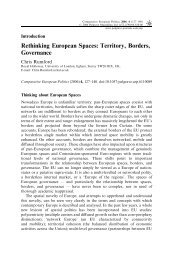Europeanisation, National Identities and Migration ... - europeanization
Europeanisation, National Identities and Migration ... - europeanization
Europeanisation, National Identities and Migration ... - europeanization
Create successful ePaper yourself
Turn your PDF publications into a flip-book with our unique Google optimized e-Paper software.
German trade unions <strong>and</strong> Polish migrant workers 207<br />
enterprises.’ Consequently the passing of a European ‘Posting of Workers directive’<br />
was dem<strong>and</strong>ed (Foundation Stone 94/10: 2). With regard to the requested directive,<br />
it was argued that a responsible European policy for the economy <strong>and</strong> the workers<br />
of one’s own country cannot mean opening borders <strong>and</strong> h<strong>and</strong>ing over the labour<br />
market to market forces; in particular when other member states secure their labour<br />
markets with regulation of minimum st<strong>and</strong>ards (Foundation Stone 94/11: 2). A month<br />
later, a report was published about a federal conference of works councils. At this<br />
gathering, the chairman of the construction trade union again touched on the<br />
problem: ‘With the opening of European labour markets since 1 January 1993,<br />
we face a situation that creates a need for reforms in the area of the protection of<br />
the social flank of labour’ (Foundation Stone 94/12). In March 1995 the German<br />
construction trade union organised a European conference in Bonn, devoted to the<br />
situation in the construction industry <strong>and</strong> the regulation of the mobility of labour<br />
(cf. Köbele <strong>and</strong> Leuschner 1995). Here, on the one h<strong>and</strong>, trade unions repeated the<br />
call to close the border to foreign contract workers from CEE-countries. On the<br />
other h<strong>and</strong>, the enactment of the European directive or comparable protection<br />
clauses at national levels were dem<strong>and</strong>ed with respect to the European posted<br />
workers. When the enactment of the European directive was delayed, the IG BAU<br />
returned to the national arena <strong>and</strong> finally reached an agreement that statutory levels<br />
of pay <strong>and</strong> employment would be stipulated by a national law, which would come<br />
into force in 1997 (Worthmann 1998).<br />
Workers from CEE-accession states as interlopers<br />
In spite of the fact that the employment of both categories – CEE as well as EU<br />
workers – caused comparable problems, the coping strategy was different. Exclusive<br />
in the one direction <strong>and</strong> inclusive in the other. The difference in treatment cannot<br />
be derived from differences in the situation on the construction site. Reports<br />
by trade unions <strong>and</strong> official authorities substantiate the claim that statutory<br />
conditions of pay <strong>and</strong> work were not being met by East European or by EU-sending<br />
enterprises (BMAS 1997). The different rhetoric vis-à-vis East European workers<br />
can be explained only with reference to the overarching legal frame, which<br />
permitted the preferred strategy of exclusion only with regard to the citizens of non-<br />
EU member states. With regard to the workers from EU member states, exclusion<br />
had no legal basis. IG BAU was forced to develop new strategies to defend its<br />
members’ interests. The only possible way to act in accordance with the European<br />
political opportunity structure was to attempt to include EU workers as much<br />
as possible in the German social <strong>and</strong> tariff order, in order to reduce the gap in labour<br />
costs. With the dem<strong>and</strong> for the integration of posted workers into the system<br />
of social protection, the boundaries between domestic <strong>and</strong> foreign workers<br />
were significantly re-shaped. Following official provisions, posted workers from EU<br />
member states were no longer treated as a category of foreign workers exposed<br />
to open exclusionist claims.<br />
With the national regulations providing equal pay <strong>and</strong> working conditions for<br />
all workers regardless of nationality coming into force in 1997, a measure was



